Dover, DE Pollen and Allergy Report for Summer 2023
Pollen Allergy Trends in Dover, DE
When is pollen lowest in Dover, DE?

February
Lowest month total PPM
Avg. PPM
When is pollen highest in Dover, DE?

April
Highest month total PPM
Avg. PPM
How does pollen in Dover, DE compare to Delaware?
Dover has a equal average PPM than the state of Delaware.
Dover yearly avg PPM:
Delaware yearly avg PPM:
How does pollen in Dover, DE compare to the USA?
Dover has a higher average PPM than the USA.
Dover yearly avg PPM:
USA yearly avg PPM:
Is pollen worse this year in Dover, DE?
Spring 2023 was worse than spring 2022.
Spring 2023 PPM:
Spring 2022 PPM:
Average PPM in Dover, DE
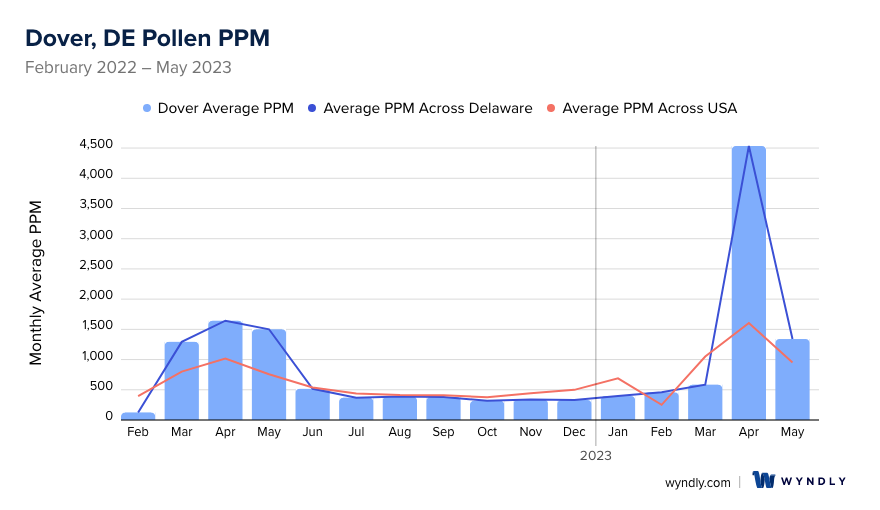
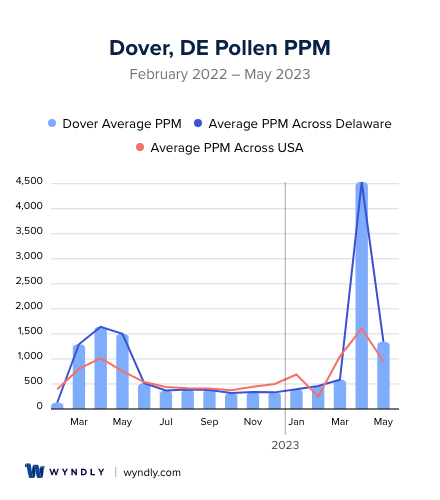
Dover, DE Pollen and Allergy Breakdown by Month
Grass
When is grass pollen highest in Dover, DE?
April has the highest grass pollen in Dover, DE with an average PPM of
When is grass pollen lowest in Dover, DE?
December has the lowest grass pollen in Dover, DE with an average PPM of
Tree
When is tree pollen highest in Dover, DE?
April has the highest tree pollen in Dover, DE with an average PPM of
When is tree pollen lowest in Dover, DE?
October has the lowest tree pollen in Dover, DE with an average PPM of
Weed
When is weed pollen highest in Dover, DE?
April has the highest weed pollen in Dover, DE with an average PPM of
When is weed pollen lowest in Dover, DE?
February has the lowest weed pollen in Dover, DE with an average PPM of
Dover, DE Pollen Monthly Breakdown by Pollen Type
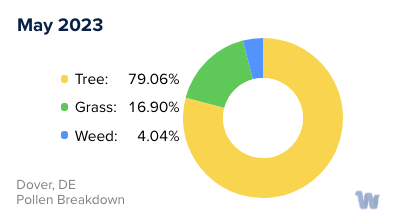
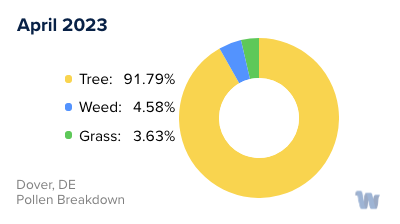
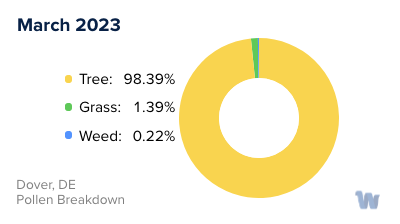

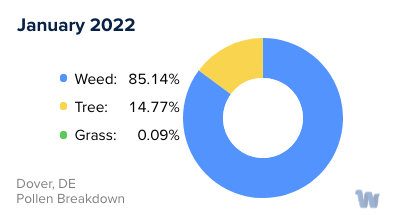
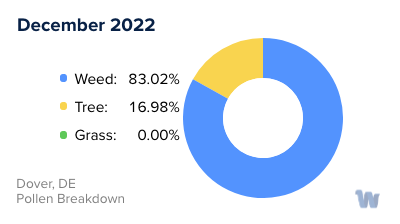
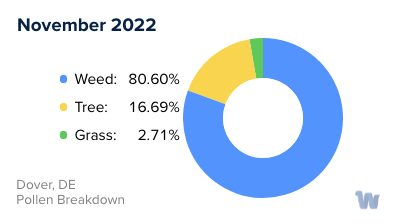
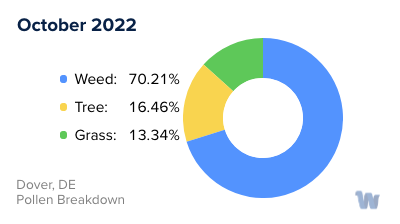
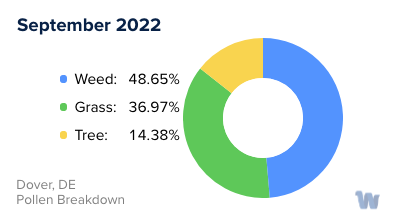
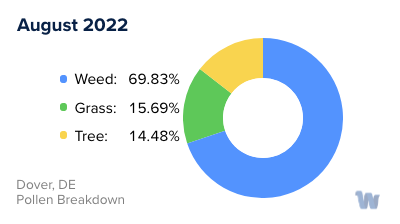
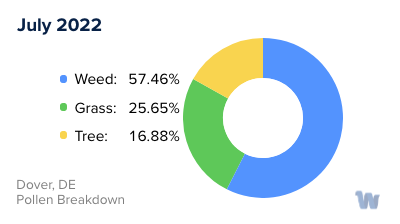
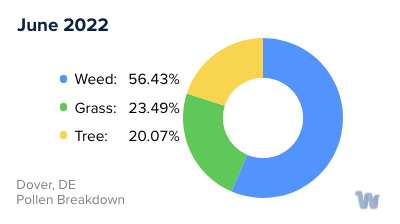
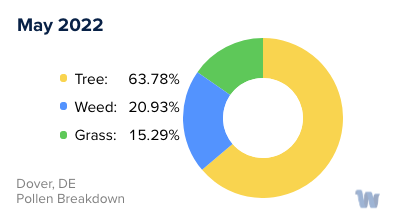
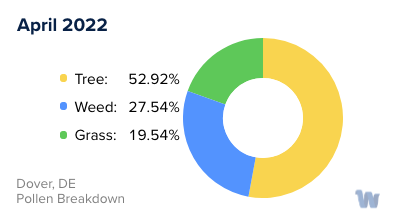
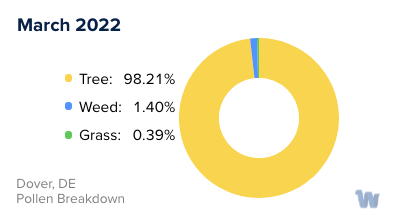
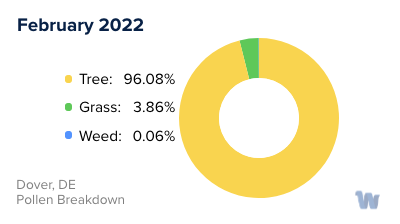
Pollen and Hay Fever in Dover, DE
If you're living in Dover, Delaware, you might be all too familiar with the sniffling, sneezing, and itchy eyes that come with pollen allergies. These symptoms, often grouped under the term "hay fever," are your body's response to certain types of airborne pollen present in the environment at various times of the year.
In Dover, like many parts of the United States, the major types of pollen that trigger allergies come from trees, grasses, and weeds. Each type of pollen has its own 'season,' during which it is produced and released into the air.
Tree pollen season typically begins in late winter and continues into spring. The most common trees in Dover that contribute to pollen allergies include oak, maple, and pine. These trees release tiny, light, dry pollen grains that are easily carried by the wind, leading to widespread exposure.
Following the tree pollen season, grass pollen takes over, usually peaking in late spring and early summer. If you find your allergy symptoms kicking in during this time, it could be due to the common grasses in the Dover area, such as ryegrass, Kentucky bluegrass, and fescue.
Finally, weed pollen season usually begins in late summer and extends into fall. This is the time when plants like ragweed, sagebrush, and lamb’s quarters release their pollen. Ragweed, in particular, is a significant allergen and is common in the Dover area.
The timing and severity of these pollen seasons can vary from year to year, based on factors such as temperature, rainfall, and wind patterns. For example, a warmer winter might cause trees to pollinate earlier, extending the tree pollen season. Similarly, a rainy spring could lead to more grass growth, potentially increasing grass pollen levels.
Understanding the types of pollen and their seasons can be the first step in managing your pollen allergies. Being aware of which plants are pollinating at different times of the year can help you anticipate when your symptoms might flare up, allowing you to plan your outdoor activities accordingly.
Remember, each person's experience with pollen allergies is unique, depending on their specific sensitivities and the local environment. If you're experiencing hay fever symptoms, a healthcare professional can help identify the specific triggers and provide guidance on how to best manage your symptoms.

